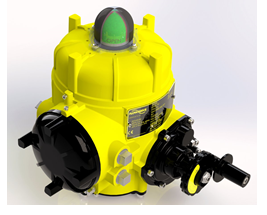 |
New Limitorque CEA Series Valve Actuator
Courtesy Flowserve Corp. |
Industrial process control encompasses a broad range of fluid handling operations. A significant part of fluid control is accomplished by valves, many of which are operated automatically through the use of actuators. Actuators are mounted on valves in place of, or in addition to, a handwheel, lever, or other manual means of opening and closing the valve. With an actuator installed, a control signal can be transmitted from a remote source to the actuator, commanding a change in valve position, and the actuator will respond by converting some form of connected energy into mechanical motion that positions the valve accordingly.
Modern actuators are increasingly endowed with functions that provide information to the process operator, closing the loop with feedback that confirms the valve position, suitability of the energy supply to the actuator, and a range of other specialized data points.
An eternal desire of all process operators is a reduction in whatever level of maintenance that is currently required to keep everything operating. Maintenance is costly and time consuming, a set of many specialized tasks, each with a probability of not being completed properly.
Flowserve Corporation, under their well known Limitorque brand, has designed and launched a new series of electric actuators, the CEA Series, that provide real benefits for operation and maintenance in light-to-medium duty applications. Some of the highlights....
- Auto calibration and a user-friendly HMI provide optimized commissioning. Standard diagnostics include torque monitoring and actuator temperature, with early warning detection of undesirable conditions and an alarm output.
- Application specific brushless DC motors and worm gear drives reduce downtime. Tests have demonstrated reliability of up to 250,000 cycles. Modulating service can provide 1800 starts per hour with 0.1% position accuracy.
- Suitable for applications with rotary duty requirements of 90 and 180 degrees, as well as multi-turn duty to 20 turns.
- Available through a network of professional industrial process control distributors, with application assistance and product expertise.
- CEA is fully qualified to NEMA Type 4, 4X and6, IP66/68 Class 1, Div 1 and 2, Gps B,C,D (CSA,FM) and ATEX II 2G Ex d IIB +H2 T4: IECEx II 2G Ex d IIB +H2 T4.
The CEA actuator is available in seven sizes and five variants, serving torque requirements up to 15,000 in-lbs (1695 Nm). Contact a product specialist to find out more about this new product and discuss your potential applications.





